GLAM GAMES Uses Common—and Not-So-Common—Materials to Introduce High School Girls to Materials Science
"We get materials out there, and make people know what it is, and that it's an option, and that it's fun. It's so much fun!" – MatSE Assistant Professor, Jessica Krogstad
June 28, 2018
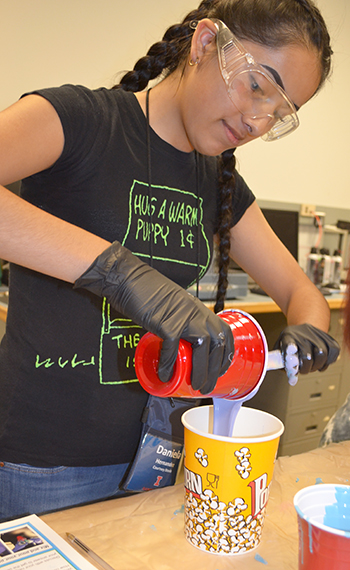
A GLAM camper pours polmer into a container to make a mold.
Sweet, yummy chocolate. What girl doesn't crave that? The ubiquitous polymers. Wild and wacky non-Newtonian fluids. Biomaterials. Composites. Crystals. These are just some of the materials 16 girls dabbled in during GLAM (Girls Learn About Materials) GAMES (Girls’ Adventures in Math, Engineering, and Science) camp from June 17–23, 2018. Plus, a design project allowed the young women to explore the characteristics of a commonplace, everyday material, such as cardboard, malleable metal (tin foil), tape, or plastic, to come up with a use that's different from how it’s normally used. All of these activities were designed to give the girls a glimpse into what materials engineering is and what a materials engineer does.
In her 4th year running GLAM GAMES, Material Science and Engineering (MatSE) Assistant Professor Jessica Krogstad reports that the 16 girls who participated in 2018 were mostly from the Chicago area. However, one camper hailed from Iowa, one from Michigan, and one came all the way from Istanbul, Turkey.
Krogstad indicates that only a handful of campers who come to GLAM year-in, year-out really know what materials engineers do; the vast majority have no idea. “We get a lot of campers who kind of like chemistry, and kind of like physics, and kind of like engineering, but aren't sure which direction to go. But this sounds like it might be some sort of combination of all that. And it really is. It's kind of the perfect mix of all those different things.”
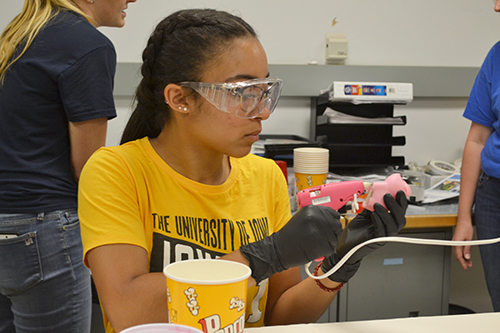
A GLAM camper prepares the object she's going to replicate by making a mold.
So one goal of the camp is to give the GLAM participants perspective as to what an actual materials engineer might do via a week-long design project.
“So it's really difficult to describe what a materials engineer does,” Krogstad explains, “because there's such a diversity of application spaces that they work in that it's no one thing. This gives them the ability to explore what they might actually do in a job on their own.”
Krogstad says GLAM didn’t have a design project when she took charge of it four years ago. It's something she and her team have integrated into the camp to give it “more cohesiveness.” It was also designed to give the campers “more ownership of their learning and to be able to apply it directly to their own creative thinking.”
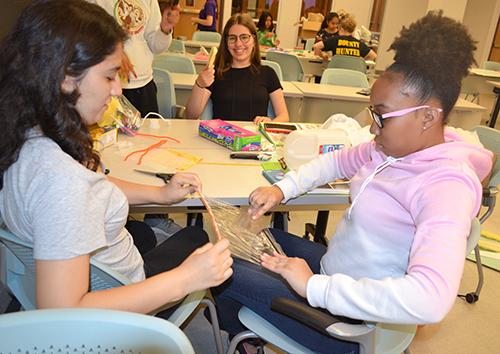
Two high schooers work on their design project with their material: saran wrap.
One thing that was different about the camp this year was the changes they made to the project. The idea was for the girls to come up with a novel application of an everyday material: either a paper-based product; a malleable metal, like aluminum foil or paper clips; tape; or plastics, like milk jugs and saran wrap—all of these come out of the recycle bin or they're things one can buy easily in the store. Then, at the end of the week, they presented their designs to visitors at a poster session.
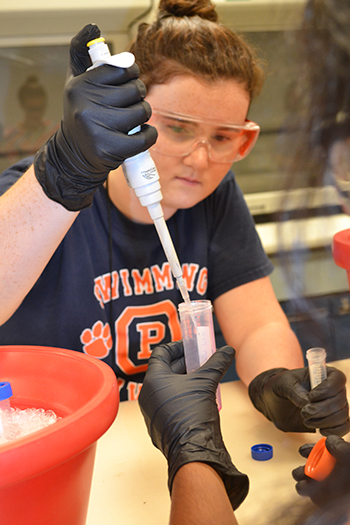
A GLAM participant uses a pipette during the biomaterials session.
Indicating that the design project has always been very popular with students in the past, Krogstad reports that they’re also doing a study in order to understand how it “improves [the campers’] confidence and their understanding of the material in camp.” The study also involves comparisons to the design projects some of the other camps do in different ways.
What is it that the campers were to design? “It's up to them,” Krogstad says. The goal was to give them materials they're very familiar with, so they're also familiar with how the material is usually used. She gives the example of cardboard, which is pretty much always used as a box. “Are there other things you can do with the box to solve a different problem?” she asks. “So we kind of put that on the teams to come up with a need or a problem that could be addressed by the properties that are discovered from the materials.”
First, the girls performed various tests on a number of materials at different stations the GLAM team had set up for testing. These were to help the girls come up with other ways a material, such as cardboard, might be used—ways that were different from how they’ve seen it used before.
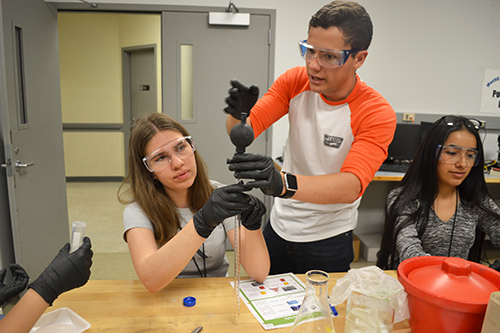
A lab assistant teaches a GLAM camper how to use a piece of equipment during the biomaterials session.
She reports that as a result of the testing, for instance, “The plastic team was really surprised by how strong the plastic bags were in some configurations, but then they were able to break them in other configurations. So they're learning about the design of the materials and why they're used and made the way they currently are for current applications, but also coming up with new insight they can use for their final, novel application space.”
Why would Krogstad and her team take a break from their research to do a camp for high schoolers? Krogstad says she had done outreach activities similar to this when she was in high school which introduced her to materials science, so she took on GLAM to pay it forward.
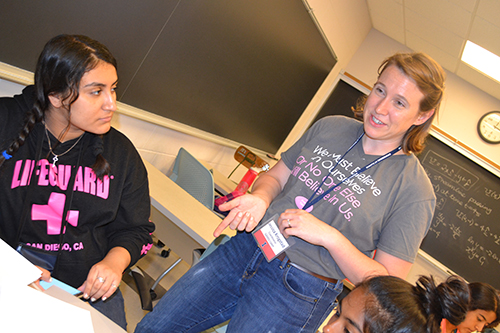
Jessica Krogstad chats with GLAM campers working on their design project.
“I didn't know what materials science was. I was going to be an aerospace engineer or a chemical engineer, and I think I would've hated both of those. They wouldn't have been a good fit for me. And through outreach activities like this, I discovered what materials science and engineering was in high school, so the whole trajectory of my career is activities like this. So it's really important for me to be able to give students these sorts of opportunities.”
One participant who discovered what materials engineering is like at GLAM was Lily Mini, a rising junior at Lyons Township High School in Western Spring, Illinois. Mini shares why she came to GLAM this summer and the impact it had on her:
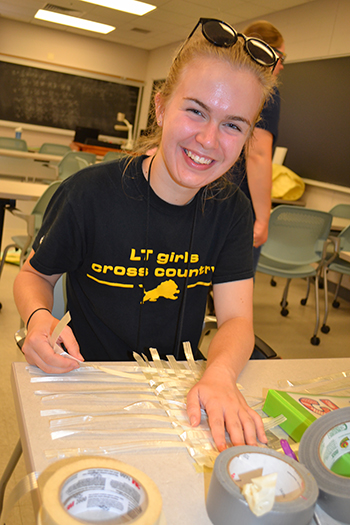
Lily Mini makes a tape creation during a project design segment.
“I’m interested in engineering, and my dad went to the University of Illinois, so there’s legacy here,” she admits. She also participated because she’s a junior, and is starting to think about college.
“It’s becoming real, and I saw this opportunity, and I thought, ‘It’s a great opportunity to explore my options as a woman interested in engineering.’” She says it was also a great opportunity to “spend time on a campus that’s near and dear to my family.” She indicates that her impression of the campus was very positive:
“I could definitely see myself here,” she acknowledges, “and it’s nice to just spend time on campus rather than just going on an hour tour—actually getting to live here.”
Regarding materials engineering, she says, “I really like how inter-disciplinary it is. I like how connected to everything. I’m really interested in how materials connect to how we do things.”
While she indicates that she might be a little bit more interested in how to do things rather than the materials one does them with, she adds, “I think it’s a really important part of the process, and it’s allowing me to use the engineering process to explore different things, so I’m glad that I’ve taken this camp and had the opportunity to do it.”
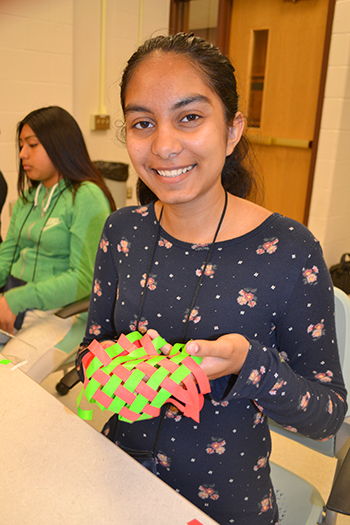
GLAM camper Mayher Matharu shows off the work she did for her team's design project, incorporating tape.
Another GLAM participant, Mayher Matharu, a rising junior at Evanston Township High School, shares why she participated in the camp.
While she says she really loves art and has loved it all of her life, she admits that, “Lately, science has been more and more interesting to me. I feel like I have a lot of catching up to do with people who’ve been involved with science all their life or for a really long time. So I’m trying to get an idea of what science is like, and what life in science would be like.”
Matharu confesses that she has a bias against engineering that she’s “trying to eliminate.” Because her dad is an engineer, and because her family is Indian, she had initially rebelled against the three main career choices expected of Indian children: an engineer, a lawyer, or a doctor.
“My mom especially tried not to do that,” she confesses regarding the three career expectations, “but I was still aware of it, and so it made me push away from science and STEM.” Ironically, she has since realized that, “I do like it,” she admits. “I have a passion for it, and I have a talent that doesn’t just come from something that you learn, it comes from actually caring about something, and I realized that I care about this, and I enjoy doing science.”
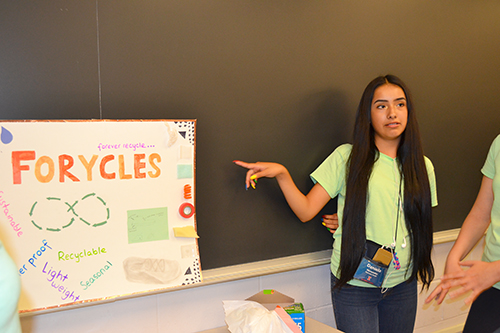
A high school student presents her team's design project at the end-of-the-camp poster session.
She says she chose the GLAM camp because she loves ceramics. Discovering that there are ceramic engineers, “who look at everything from toilets to rockets and what’s in a rocket. ('Because you can’t just put plastic in there,' she explains. 'It’ll melt!') So ceramics is a big part of that and has a wide variety of applications. So material sciences is what ceramics engineering is under and it made me consider other materials that I use every day and how those can be applied.”
Story and photos by Elizabeth Innes, Communications Specialist, I-STEM Education Initiative.
More: 8-12 Outreach, GAMES, GLAM, MatSE, Summer Camp, Women in STEM, 2018
For additional I-STEM articles about other G.A.M.E.S. camps, see:
- GLAM GAMES Camp Helps High Schoolers Explore Materials Engineering Career Options (2017)
- Girls Learn About Materials Science at the 2016 GLAM G.A.M.E.S. Camp (2016)
- GLAM Seeks to Capture Girls' Imagination About Materials (2013)

A camper learns about how to work with biomaterials during one of the camp's hands-on sessions.













.jpg)
















